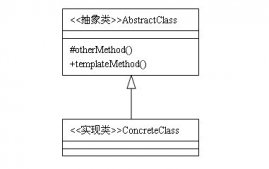文章分享了4个例子对synchronized的详细解释
1、是否加synchronized关键字的不同
|
1
2
3
4
5
6
7
8
9
10
11
12
13
14
15
16
17
18
19
20
21
22
23
24
25
26
27
28
29
30
31
32
33
34
35
36
37
38
39
|
public class ThreadTest { public static void main(String[] args) { Example example = new Example(); Thread t1 = new Thread1(example); Thread t2 = new Thread1(example); t1.start(); t2.start(); }}class Example { public synchronized void excute() { for (int i = 0; i < 5; ++i) { try { Thread.sleep(1000); } catch (InterruptedException e) { e.printStackTrace(); } System.out.println("excute:" + i); } }}class Thread1 extends Thread { private Example example; public Thread1(Example example) { this.example = example; } @Override public void run() { example.excute(); }} |
加了synchronized关键字的输出结果如下
会先输出一组0-4,接着再输出下一组,两个线程顺序执行
excute:0
excute:1
excute:2
excute:3
excute:4
excute:0
excute:1
excute:2
excute:3
excute:4
没加synchronized关键字的输出结果如下
两个线程同时执行excute方法,同时并发的
excute:0
excute:0
excute:1
excute:1
excute:2
excute:2
excute:3
excute:3
excute:4
excute:4
2、多个方法的多线程情况
|
1
2
3
4
5
6
7
8
9
10
11
12
13
14
15
16
17
18
19
20
21
22
23
24
25
26
27
28
29
30
31
32
33
34
35
36
37
38
39
40
41
42
43
44
45
46
47
48
49
50
51
52
53
54
55
56
57
58
59
60
61
|
public class ThreadTest { public static void main(String[] args) { Example example = new Example(); Thread t1 = new Thread1(example); Thread t2 = new Thread2(example); t1.start(); t2.start(); }}class Example { public synchronized void excute() { for (int i = 0; i < 5; ++i) { try { Thread.sleep(1000); } catch (InterruptedException e) { e.printStackTrace(); } System.out.println("excute:" + i); } } public synchronized void excute1() { for (int i = 0; i < 5; ++i) { try { Thread.sleep(1000); } catch (InterruptedException e) { e.printStackTrace(); } System.out.println("excute1:" + i); } }}class Thread1 extends Thread { private Example example; public Thread1(Example example) { this.example = example; } @Override public void run() { example.excute(); }}class Thread2 extends Thread { private Example example; public Thread2(Example example) { this.example = example; } @Override public void run() { example.excute1(); }} |
执行结果如下
同样是顺序执行,执行完一个线程再执行另一个线程
excute:0
excute:1
excute:2
excute:3
excute:4
excute1:0
excute1:1
excute1:2
excute1:3
excute1:4
如果去掉synchronized关键字,则两个方法并发执行,并没有相互影响。
但是如例子程序中所写,即便是两个方法:
执行结果永远是执行完一个线程的输出再执行另一个线程的。
说明:
如果一个对象有多个synchronized方法,某一时刻某个线程已经进入到了某个synchronized方法,那么在该方法没有执行完毕前,其他线程是无法访问该对象的任何synchronized方法的。
结论:
当synchronized关键字修饰一个方法的时候,该方法叫做同步方法。
Java中的每个对象都有一个锁(lock),或者叫做监视器(monitor),当一个线程访问某个对象的synchronized方法时,将该对象上锁,其他任何线程都无法再去访问该对象的synchronized方法了(这里是指所有的同步方法,而不仅仅是同一个方法),直到之前的那个线程执行方法完毕后(或者是抛出了异常),才将该对象的锁释放掉,其他线程才有可能再去访问该对象的synchronized方法。
注意这时候是给对象上锁,如果是不同的对象,则各个对象之间没有限制关系。
尝试在代码中构造第二个线程对象时传入一个新的Example对象,则两个线程的执行之间没有什么制约关系。
3、静态的同步方法
当一个synchronized关键字修饰的方法同时又被static修饰,之前说过,非静态的同步方法会将对象上锁,但是静态方法不属于对象,而是属于类,它会将这个方法所在的类的Class对象上锁。
|
1
2
3
4
5
6
7
8
9
10
11
12
13
14
15
16
17
18
19
20
21
22
23
24
25
26
27
28
29
30
31
32
33
34
35
36
37
38
39
40
41
42
43
44
45
46
47
48
49
50
51
52
53
54
55
56
57
58
59
60
61
|
public class ThreadTest { public static void main(String[] args) { Example example = new Example(); Example example2 = new Example(); Thread t1 = new Thread1(example); Thread t2 = new Thread2(example2); t1.start(); t2.start(); }}class Example { public synchronized static void excute() { for (int i = 0; i < 5; ++i) { try { Thread.sleep(1000); } catch (InterruptedException e) { e.printStackTrace(); } System.out.println("excute:" + i); } } public synchronized static void excute1() { for (int i = 0; i < 5; ++i) { try { Thread.sleep(1000); } catch (InterruptedException e) { e.printStackTrace(); } System.out.println("excute1:" + i); } }}class Thread1 extends Thread { private Example example; public Thread1(Example example) { this.example = example; } @Override public void run() { example.excute(); }}class Thread2 extends Thread { private Example example; public Thread2(Example example) { this.example = example; } @Override public void run() { example.excute1(); }} |
执行结果如下
excute:0
excute:1
excute:2
excute:3
excute:4
excute1:0
excute1:1
excute1:2
excute1:3
excute1:4
如果没有static修饰符,两个线程分别传入不同的对象,则会同时并发执行
所以如果是静态方法的情况(execute()和execute2()都加上static关键字),即便是向两个线程传入不同的Example对象,这两个线程仍然是互相制约的,必须先执行完一个,再执行下一个。
结论:
如果某个synchronized方法是static的,那么当线程访问该方法时,它锁的并不是synchronized方法所在的对象,而是synchronized方法所在的类所对应的Class对象。Java中,无论一个类有多少个对象,这些对象会对应唯一一个Class对象,因此当线程分别访问同一个类的两个对象的两个static,synchronized方法时,它们的执行顺序也是顺序的,也就是说一个线程先去执行方法,执行完毕后另一个线程才开始。
4.synchronized块
synchronized(object)
{
}
表示线程在执行的时候会将object对象上锁。(注意这个对象可以是任意类的对象,也可以使用this关键字)。
这样就可以自行规定上锁对象。
|
1
2
3
4
5
6
7
8
9
10
11
12
13
14
15
16
17
18
19
20
21
22
23
24
25
26
27
28
29
30
31
32
33
34
35
36
37
38
39
40
41
42
43
44
45
46
47
48
49
50
51
52
53
54
55
56
57
58
59
60
61
62
63
64
65
66
|
public class ThreadTest { public static void main(String[] args) { Example example = new Example(); Thread t1 = new Thread1(example); Thread t2 = new Thread2(example); t1.start(); t2.start(); }}class Example { public void excute() { synchronized (this) { for (int i = 0; i < 5; ++i) { try { Thread.sleep(1000); } catch (InterruptedException e) { e.printStackTrace(); } System.out.println("excute:" + i); } } } public void excute1() { synchronized (this) { for (int i = 0; i < 5; ++i) { try { Thread.sleep(1000); } catch (InterruptedException e) { e.printStackTrace(); } System.out.println("excute1:" + i); } } }}class Thread1 extends Thread { private Example example; public Thread1(Example example) { this.example = example; } @Override public void run() { example.excute(); }}class Thread2 extends Thread { private Example example; public Thread2(Example example) { this.example = example; } @Override public void run() { example.excute1(); }} |
执行结果如下
excute:0
excute:1
excute:2
excute:3
excute:4
excute1:0
excute1:1
excute1:2
excute1:3
excute1:4
例子程序4所达到的效果和例子程序2的效果一样,都是使得两个线程的执行顺序进行,而不是并发进行,当一个线程执行时,将object对象锁住,另一个线程就不能执行对应的块。
synchronized方法实际上等同于用一个synchronized块包住方法中的所有语句,然后在synchronized块的括号中传入this关键字。当然,如果是静态方法,需要锁定的则是class对象。
可能一个方法中只有几行代码会涉及到线程同步问题,所以synchronized块比synchronized方法更加细粒度地控制了多个线程的访问,只有synchronized块中的内容不能同时被多个线程所访问,方法中的其他语句仍然可以同时被多个线程所访问(包括synchronized块之前的和之后的)。
结论:
synchronized方法是一种粗粒度的并发控制,某一时刻,只能有一个线程执行该synchronized方法;
synchronized块则是一种细粒度的并发控制,只会将块中的代码同步,位于方法内、synchronized块之外的其他代码是可以被多个线程同时访问到的。
以上就是关于java多线程编程Synchronized块同步方法,希望对大家的学习有所帮助。















